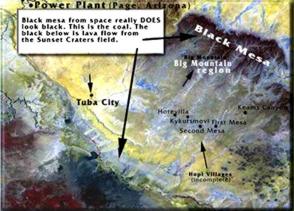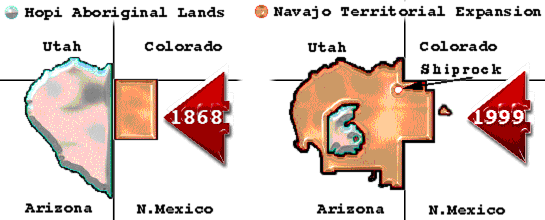The Kachina Factories
Do you know what a kachina is?
In the Hopi religion, they are called "katsinas" and, really,
if you'd like to talk about respecting religions, we have to begin
with the premise that we don't know what the Hopi religion is
about, not really. We know that by Hopi tradition, Katsina dolls
are given to children during annual ceremonies. These are hung in
the home to remind the children of the Katsinas' importance to
everyday Hopi life. The Heard Museum in Phoenix notes, in part, on
their web page: http://www.heard.org/education/rain/cultura3/raincul8.html
- Only an initiated Hopi adult has the appropriate knowledge
and right to make an image of a Katsina or Katsina doll.
- Young, uninitiated Hopi children are not allowed to draw or
otherwise represent a Katsina, even a color-by-number figure.
- Katsina dolls should only be carved by certain people. A
non-Hopi person should not be encouraged to carve, draw, or make
any image of a Katsina
The practice of selling Kachina dolls dates back to the late
19th century opening of the Santa Fe railroads main line, and Fred
Harveys tours of the Painted Desert and the Hopi mesas, when
passengers became fascinated with the quaint little dolls, and
insisted on buying as many as the Hopi could carve. The commercial
sale of kachinas has been a thriving business, and an economic
mainstay of the tribe ever since. [Note: I use the term kachina
for the commercially available dolls. This differs from katsinas
which represent the pantheon of Hopi religion, and will not be
mentioned again.]
Nonetheless, the Navajo (who have no kachinas) have never been
shy about carving and selling kachinas (a Google search for Navajo
Kachina turns up 470 links to sites selling and discussing Navajo
Kachinas.) a sore point with the Hopi for many many years. Indeed,
there are, at present, at least three factories turning out
authentic kachinas, including one in Gallup, New Mexico, and one
in Grants (pictured).  They are assembly-line operations,
with a Navajo at the end of the line signing the kachinas, so they
can be sold as "authentic Navajo kachinas."
They are assembly-line operations,
with a Navajo at the end of the line signing the kachinas, so they
can be sold as "authentic Navajo kachinas."
All tribes suffer from fake trinkets knockoffs -- as many as
70% of all NDN artifacts are phony, estimates the Smithsonian --
but the predation of the Hopi tribes (total pop. approximately
11,000) religion and handiwork by the only tribe located
surrounding another -- a tribe that asks you call it the Navajo
Nation, with some justification as the largest tribe in the United
States, at 270,000 members, and a reservation that has grown,
since 1868 to the size of West Virginia -- seems astonishing.
The word kachina is unique to the Hopi tribe and Hopis object
to its use by other tribes. But Democratic Rep. Benjamin Hanley,
a Navajo from Window Rock, Ariz. said an Indian is an Indian as
I see it and the kachina is a commercialized product now that it
is no longer solely a religious symbol. Hanley voted against the
bill.
Senate fails to pass stiffer laws against
Indian arts fraud - Arizona Daily Wildcat, April 5,
1996
Is this astonishing religious oppression? Is this monumental
economic oppression? And isn't this also a metaphor for the entire
relationship between Hopi and Navajo, at least as told by the
Hopi? The answer to the last question is yes.
Over 100,000 imitation and fake kachina dolls are sold as
"Hopi" every year - a huge problem for a tribe of which over 70%
of its members earn part of their income from arts and crafts.
Does the Navajo tribe acknowledge that this is a problem and
work with the Hopi to correct it? No.
Do the vast majority of visitors to and/or residents of the
Southwest know anything about this religious controversy? No. Did
you?
Injuns is Injuns

The complexities of the Hopi/Navajo land dispute have resolved
themselves to perhaps ten families representing perhaps eighty
people, total. But the battle isn't about numbers anymore, its
about ideologies. Its about world views. And, at least according
to the resisters of the 'Sovereign Dineh Nation,' it's about
'religious oppression.'
But most people don't even know who the Hopi and the Navajo
are, let alone the nature of the long struggle that, technically
was resolved in March 2001, when, after 111 years of struggle with
Washington, D.C., the Hopi finally cleared title to what remained
of their ancestral lands.
The Hopi are village-dwelling, agrarian people. Old Oraibi, on
the First Mesa, is the oldest continuously inhabited settlement in
the U.S. lower 48, and was founded about 1050 AD. The Hopi culture
infuses dry farming and daily life with a sophisticated and
all-encompassing religious observance that is paralleled, perhaps,
only in Tibetan culture. Religion, daily life and land are
considered inseparable.
They have occupied their current mesas for thousands of years,
and are thought to be the descendants of the Anasazi (a Navajo
term meaning the old ones as in the old ones who built the
cliff-dwellings, the villages, the endless ruins of cities that
dot the Southwest as thick as bugs on a windshield on a summer
day). The Anasazi built Mesa Verde; they built Chaco Canyon, the
cliff dwellings, the ruins at Pecos National Monument, and,
significantly, the ruins, fields and orchards at Canyon de Chelly
(pronounced CAN-yon de SHAY). The Navajo, on the other hand, are a
nomadic people, who, in the late 19th Century, adopted
sheep-herding as a preferred way of life.
"... the nomadic Navajo ... people are considered an
adaptive culture. They rapidly adjust to new forms of livelihood
and technology and integrate them into their way of life without
disturbing their basic values and spirit. This was so in their
acquisition of sheep and horses [from the Spanish]."
-- Dr. Gerald M. Knowles, "The
Navajo"
Their language is Athabaskan, and they call themselves the
D'ineh or "the people." Archaeological evidence indicates that
they migrated from the region of the Northwest Territories in
Canada to the American Southwest, arriving at approximately the
same time as the Spanish, in the 16th century. (This last fact is
vehemently, although baselessly, disputed by SDN supporters, since
it tends to delegitimize their contention that they have "always"
been where they are, and have "always" herded sheep).
| The current trouble stems from the refusal
of a handful of Navajo to respect the rights of an entire
nation, the Hopi people, to security in their own homeland.
10 Navajo families have refused to accept an accommodation
agreement and have refused to voluntarily leave Hopi land.
|
Milland Lomakema, Sr., the world-renowned Hopi artist,
Executive Director of the Hopi Arts & Crafts Guild and member
of the Cultural Centers Museum Board explained it: "A hogan is an
igloo." He recalls that there has always been tension between the
Hopi and Navajo.
There is a long and well-documented history of the Navajo as
raiders (hunter/gatherers who hunted people and gathered their
goods) as far back as the Spanish administration of New Mexico.
One of the saddest periods of Hopi history came during the
Spanish rule, when Hopi women and children by virtue of their
intelligence and nonviolence became highly prized merchandise in
the Santa Fe slave market, and were regularly kidnapped from the
fields by Navajo raiders. The only time in memory that the Hopi
ever went to war was against the Navajo, and then to protect their
very homes.
Indeed, after the U.S. conquest of the Southwest in 1848, the
first question that pueblo and Spanish residents sent emissaries
to Santa Fe to ask was: Will you protect us from the Navajo? Among
them, in 1850, was a delegation of Hopis who traveled to Santa Fe
to complain about Navajo depredations to James S. Calhoun, the
U.S. Agent for the newly acquired territory of New Mexico (which
included what is now Arizona).
Within the past two hundred years, the Navajo have stolen Hopi
crops, raped Hopi women, stolen Hopi livestock, and murdered Hopi
children. The Hopi understandably call the Navajo the "tesavu"
"head-bangers" or "beaters" is one translation. It relates to the
favored Navajo method of killing (according to the Hopi): smashing
in ones skull.
"Tavasuh - Hopi word of contempt for a Navajo
(means head-pounder), From 'A Tony Hillerman Glossary by J
& G Vaughan'
The pueblo term for Navajo means "newcomers." On the other
hand, the name "Hopi" means the "peaceful (or "virtuous") ones."
You can tell a lot about a people from the name they've
acquired from other peoples. Everyone's name for themselves is,
the people. In Navajo, the people is the t'ineh, or the d'ineh (a
phoneme, a language sound building-block, t' or d' is a non-vocal
consonant, like "ch", t' or d' is shared by several NDN languages,
for instance, Kiowa.) For gringos, its "US."
The peaceful Hopi, having never gone to war with the U.S. were
thus never granted a treaty, and, in 1882, President Chester
Arthur created the Hopi reservation, with the proviso that the
reservation was also for "such other Indians as the Secretary of
the Interior may see fit to settle thereon." Those "other Indians"
were the present-day Navajo. It was to be a clash of utterly alien
cultures.
In 1882, President Chester Arthur laid out a map of the Four
Corners region (an area laid out by a mapmaker who'd never seen
it) and drew another rectangle. This was to be the Moqui
reservation (the old term for Hopi). And all the Indians in it
were the same, weren't they? Injuns was injuns, after all.
Tell Me A Story
In its 1999 documentary "Trees for Mother Earth," San Francisco
PBS station KQED reported just what the Navajo in Canyon de Chelly
told them: that the Navajo had built the cliff dwellings of Canyon
de Chelly, and planted its fields and orchards. While demonstrably
not true, the Navajo interviewed clearly believed it, since that
was what they'd been told. KQED mindlessly repeated the false
claim.
So, a fundamental misunderstanding of who resides in the
Southwest, and who the Navajo and Hopi are is not a new problem.
It's really at the root of the problem. At the dawn of the
Twenty-first Century, Americans still know as little about the
original inhabitants of the conquered continent, seemingly, as
they did when they first arrived: virtually nothing. Hopis,
Navajo: same thing, right?
This much I was told over and over again: "Lets clear this up,"
said Alph Secakuku, author of Following The Sun And Moon - The
Hopi Kachina Tradition, from a couch in his shop on the First
Mesa, "The Hopi and the Navajo have never had good
relations!"
It is well to begin with one unassailable fact: the Hopi have
occupied the lands they now inhabit for at least one thousand
years. There is evidence that the figure (for their ancestors) is
closer to ten thousand years, but one thousand is accepted without
controversy.
Two more unlikely cultures have rarely been mistaken for one
another -- but "injuns is injuns" seemed to fuel the thinking in
Washington D.C., and the Navajo, released in 1868 from Bosque
Redondo, and suddenly herding dubiously acquired Spanish Merino
sheep, increasingly encroached upon traditional Hopi lands. All
Navajo land holdings were acquired during the last 150 years.
Meanwhile, the loss of traditional Hopi lands was staggering.
In his Master's Thesis abstract, William Havens, relates: "the
Navajo Nation grew from 3.5 million acres in 1868 to over 16
million acres, while their neighbors, the Hopis, have lost over
40% of their original reservation land."

For a long time, there was an area called "joint-use" land. In
practice, as virtually any Hopi will be happy to tell you, the
Navajo used the land, and woe to the Hopi who tried to run
livestock on it, or live there. Beatings, fence-cuttings,
livestock mutilation, harassment and shootings were common. So it
was decided to split the lands into Hopi Partitioned Lands (HPL),
and Navajo Partitioned lands (NPL). The Navajo Nation got the
lion's share of the split, and the Hopi on the wrong side of the
fence reluctantly, but lawfully moved from their ancestral lands,
and, impossibly (at least according to the relocation scenario of
expert Dr. Thayer Scudder) did not die in droves, etc. The
percentages of relocatees, as a function of tribal populations,
were the same.
However, aided by radical AIM elements, by white hippie lawyers
and 'New Age' do-gooders, the "phony land war" scenario was
developed and funded, an artifact of a very specific era of
American history. The Navajo resisters began their long sit-in,
and filed lawsuit after lawsuit, held Lakota Sioux sundances at Camp Anna Mae and
traveled repeatedly to the United Nations, claiming religious
persecution.
"To say Navajos are incapable of moving is to deny historical
reality," Ross Swimmer, Cherokee, Bureau of Indian Affairs Head,
1987
So, how does the SDN fight this? Simple: they say it is all a
lie. "The Hopis and the Navajos have always lived together and
gotten along," they say, in defiance of evidence and reason.
Luckily, injuns is still injuns, and they are readily believed.
"The Creator gave us sheep," say the Navajo, which would seem
to elevate the Spaniard to deity. Or, perhaps, a more charitable
explanation would be that Navajo is an oral tradition (actually a
series of clans and traditions), and oral traditions tend to
change over time and with the times. The stories also tend to
change in a manner convenient to the tellers.
The Navajo of Canyon de Chelly undoubtedly believe that their
ancestors built the cliff dwellings and farmed the bottomland
originally.
If you tell a story long enough, it acquires the semblance of
fact. So, too, the stories of the SDN, which reflect the times of
the founding of Camp Anna Mae the height of the 1960s anti-war,
pro-everything movement (the early 1970s). One of the most
prominent features of that time was the counter-cultures firm
belief in conspiracy theories.
Part Two
[Comment on this article or, subscribe to our monthly
newsletter.]

 They are assembly-line operations,
with a Navajo at the end of the line signing the kachinas, so they
can be sold as "authentic Navajo kachinas."
They are assembly-line operations,
with a Navajo at the end of the line signing the kachinas, so they
can be sold as "authentic Navajo kachinas." 
